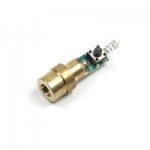Hi everyone,
I am very much new to lasers, and am attempting to build a 3D laser scanner using a laser line module I purchased and the David Laser Scanner tutorial.
My question is simple: how do I power the laser? The spec sheet states the Operating Voltage is 4.5V DC, and the Operating Current is 30mA. It is a 650nm, 5mW laser line module.
I was able to power the laser using 3 AA batteries, but was wondering two things:
1) is this safe and economical? (i.e. will I burn the laser, and how long will the batteries last)
2) what is the best way to go about putting together a power supply?
I have spent a lot of time reading different threads and tutorials, and have tried to learn about drivers, diodes, voltage regulators, etc. I am still very much confused about the role of each of these in powering a laser.
I am also wondering if I could use a wall charger from another device, one rated at 5V for example, but whose current is more than 30mA...say 50 or 100mA.
If anyone can help (even if it is links to tutorials or more information I should be reading) I would really appreciate it.
I have attached a picture of the laser module for reference.
I am very much new to lasers, and am attempting to build a 3D laser scanner using a laser line module I purchased and the David Laser Scanner tutorial.
My question is simple: how do I power the laser? The spec sheet states the Operating Voltage is 4.5V DC, and the Operating Current is 30mA. It is a 650nm, 5mW laser line module.
I was able to power the laser using 3 AA batteries, but was wondering two things:
1) is this safe and economical? (i.e. will I burn the laser, and how long will the batteries last)
2) what is the best way to go about putting together a power supply?
I have spent a lot of time reading different threads and tutorials, and have tried to learn about drivers, diodes, voltage regulators, etc. I am still very much confused about the role of each of these in powering a laser.
I am also wondering if I could use a wall charger from another device, one rated at 5V for example, but whose current is more than 30mA...say 50 or 100mA.
If anyone can help (even if it is links to tutorials or more information I should be reading) I would really appreciate it.
I have attached a picture of the laser module for reference.
Attachments
Last edited:









